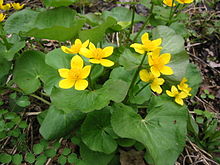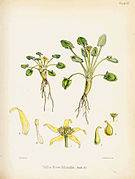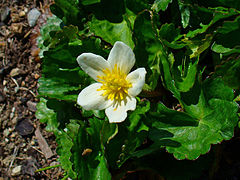
Ranunculaceae is a family of over 2,000 known species of flowering plants in 43 genera, distributed worldwide.

Caltha palustris, known as marsh-marigold and kingcup, is a small to medium sized perennial herbaceous plant of the buttercup family, native to marshes, fens, ditches and wet woodland in temperate regions of the Northern Hemisphere. It flowers between April and August, dependent on altitude and latitude, but occasional flowers may occur at other times.
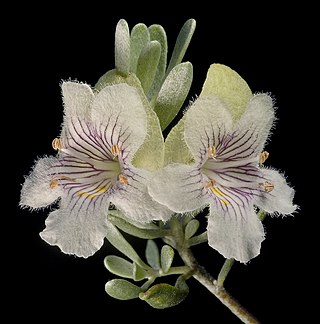
Prostanthera, commonly known as mintbush or mint bush, is a genus of about 100 species of flowering plants in the mint family Lamiaceae, and all are endemic to Australia. Plants are usually shrubs, rarely trees with leaves in opposite pairs. The flowers are arranged in panicles in the leaf axils or on the ends of branchlets. The sepals are joined at the base with two lobes. The petals are usually blue to purple or white, joined in a tube with two "lips", the lower lip with three lobes and the upper lip with two lobes or notched.

Anemone hepatica, the common hepatica, liverwort, liverleaf, kidneywort, or pennywort, is a species of flowering plant in the buttercup family Ranunculaceae, native to woodland in temperate regions of the Northern Hemisphere. This herbaceous perennial grows from a rhizome.

Caltha leptosepala, the white marsh marigold, twinflowered marsh marigold, or broadleaved marsh marigold, is a North American species of flowering plant in the buttercup family. The species has regionally distinct variations.
This glossary of botanical terms is a list of definitions of terms and concepts relevant to botany and plants in general. Terms of plant morphology are included here as well as at the more specific Glossary of plant morphology and Glossary of leaf morphology. For other related terms, see Glossary of phytopathology, Glossary of lichen terms, and List of Latin and Greek words commonly used in systematic names.

Paeonia delavayi is a low woody shrub belonging to the peonies, that is endemic to China. The vernacular name in China is 滇牡丹. In English it is called Delavay's tree peony, Delavay peony, Dian peony, and dian mu dan. It mostly has red brown to yellow, nodding flowers from mid May to mid June. The light green, delicate looking deciduous leaves consist of many segments, and are alternately arranged on new growth.

Paeonia ludlowii, is a deciduous shrub of medium height, belonging to the tree peony section Moutan of the genus Paeonia, and endemic to southeast Tibet. In Tibet it is known as ≠'lumaidao' meaning "God's flower". The vernacular name in Chinese is 大花黄牡丹 meaning "big yellow-flowered peony". In English it is sometimes called Tibetan tree peony or Ludlow's tree peony. It has pure yellow, slightly nodding, bowl-shaped flowers, and large, twice compounded, light green leaves.
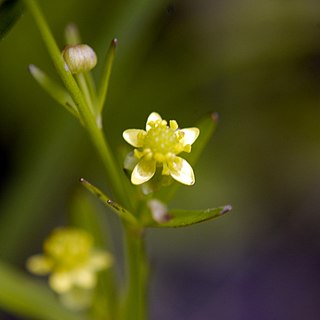
Ranunculus abortivus is a species of flowering plant in the buttercup family, Ranunculaceae. Its common names include littleleaf buttercup, small-flower crowfoot, small-flowered buttercup, and kidneyleaf buttercup. It is widespread across much of North America, found in all ten Canadian provinces as well as Yukon and the Northwest Territories, and most of the United States, except Hawaii, Oregon, California, and parts of the Southwest.

Caltha natans is a species of flowering plant in the buttercup family. It goes by the common name floating marsh marigold.
Caltha appendiculata is a perennial herb plant found in several countries of South America.

Caltha dioneaefolia is a dwarf perennial herb, of the Buttercup Family (Ranunculaceae) with apparently seated pale yellow flowers with about seven stamens and two to three free carpels and leaves that are reminiscent of those of the Venus flytrap, but very small and with leaflike appendages on the leaf. C. dioneaefolia occurs in the southern Andes of Chili and Argentina, including on Tierra del Fuego and Hermite Island.
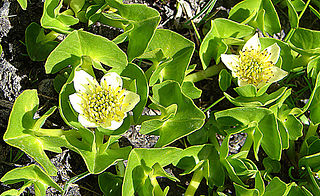
Caltha sagittata is a low to medium height, rhizomatomous perennial herb with ivory hermaphrodite flowers, belonging to the Buttercup family. It grows in clusters in sunny wet places in the Andes and related mountain chains. It has a disjunct distribution concentrated in the Southern Cone of South America.

Caltha novae-zelandiae, commonly known as New Zealand marsh marigold or yellow caltha, is a small, perennial herbaceous plant belonging to the family Ranunculaceae, that grows in open vegetations in mountainous areas, and is endemic to New Zealand.

Caltha obtusa; commonly known as white caltha; is a small, perennial herbaceous plant belonging to the family Ranunculaceae, that grows in open vegetations in mountainous areas, and is endemic to New Zealand's South Island.
Caltha introloba, commonly known as the alpine marsh-marigold is a small hairless, perennial alpine herb, that is endemic to the alpine regions of Australia and Tasmania.
Caltha scaposa is a low, perennial herb with one or two yellow hermaphrodite saucer-shaped flowers. This marsh-marigold species belongs to the buttercup family, grows in moist alpine fields and is native to the eastern Himalayas and the mountains on the eastern margin of the Tibetan highland.

Ranunculus allegheniensis is a species of flowering plant in the buttercup family, Ranunculaceae. Its common names include Allegheny Mountain buttercup and Allegheny crowfoot.
Hibbertia auriculiflora is a species of flowering plant in the family Dilleniaceae and is endemic to northern parts of the Northern Territory. It is usually a short-lived perennial shrublet covered with hairs and scales and has mostly oblong to linear leaves. The flowers are usually arranged singly or in groups of two or three in leaf axils, with twenty-five to thirty-two stamens arranged in groups around the two carpels.

Condylocarpon isthmicum is a species of plant in the Apocynaceae family. It is native to Argentina, Brazil, Paraguay and Uruguay. José Mariano de Conceição Vellozo, the botanist who first formally described the species, named it after the narrow neck connecting the two sections of its fruit.
